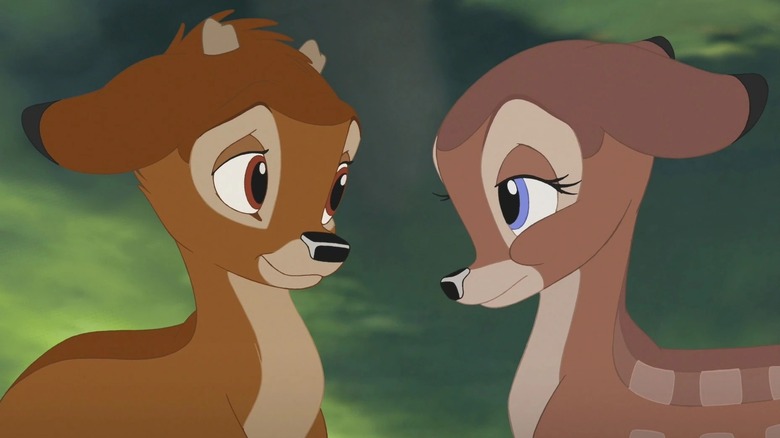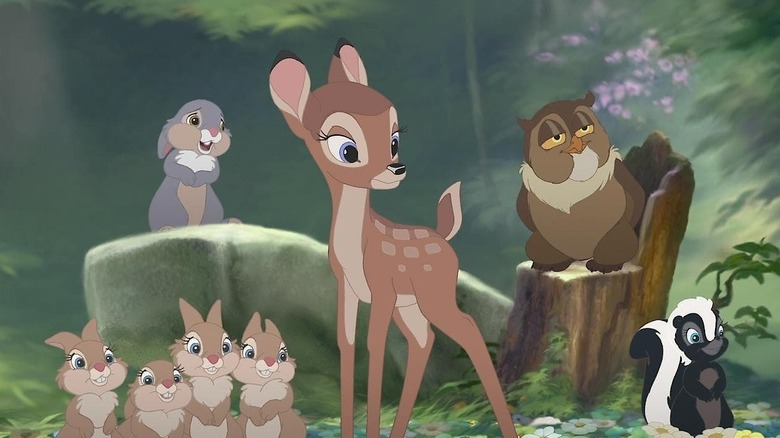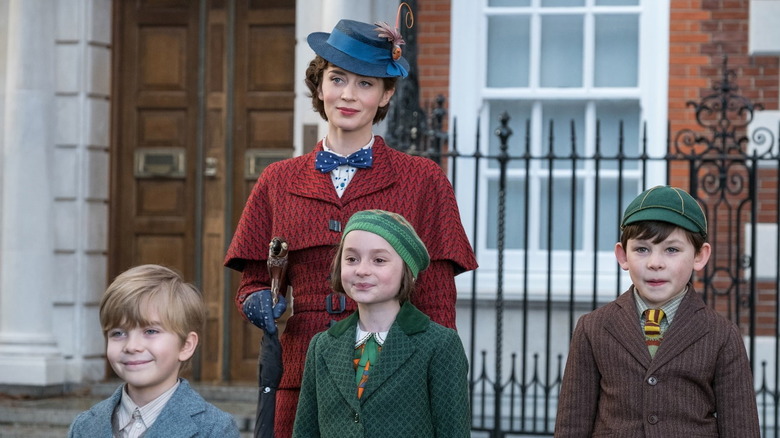Disney's Longest Gap Between A Movie And Its Sequel
There's always something fascinating about the phenomenon of late-stage sequels. Filmmakers will sometimes wait decades after a film is released to make a follow-up, which only proves that the original has either retained its cultural clout or somehow gained more traction in the mass consciousness over time. It's easy to see why, in 1985, Walter Murch decided to make a sequel to 1939's "The Wizard of Oz" called "Return to Oz." It had been about 46 years since the original had been released, but "The Wizard of Oz" had — and has — remained one of the most famous movies of all time. A sequel would merely tap into the perpetual affection American audiences have for the film.
And, of course, some long-in-the-tooth sequels are merely a matter of timing, interest, and commitment. Why were there over ten years between "Toy Story 2" (1999) and "Toy Story 3" (2010)? No other reason than that the studio was working on other things. Why did 11 years elapse between "Scream 3" and "Scream 4?" They wanted to think of a new angle.
Some of the longest gaps between sequels came from Disney, who has always been incredibly meticulous about keeping their older features in the mass consciousness in perpetuity. Several of their films from the '40s and '50s got late-stage sequels because, well, people were still intimately familiar with them. Case in point: the longest gap between the release of an original film and the release of its direct sequel was 63 years and 143 days. "Bambi" was released on August 13, 1942. Its straight-to-video sequel, "Bambi II," was released on February 7, 2006.
There are 63½ years between Bambi and Bambi II
"Bambi," for those who weren't traumatized by the film as children, is about a gentle fawn named Bambi (Bobby Stewart) as he grows up in the woods of Maine. Bambi is by the animals' own line of succession, set to become the king of the forest, as his aloof and absent father currently oversees the animals' affairs. Bambi befriends a friendly rabbit (Peter Behn) and a laconic skunk (Stan Alexander), as he survives the travails of the woods. Most notably, his mother is shot and killed by a hunter. Later in the film, the woods will catch on fire, and Bambi will have to fight to survive. "Bambi" takes place throughout Bambi's whole life, and audiences meet him as a horny adolescent (played by Hardie Albright) and as a dignified adult (John Sutherland).
"Bambi II" is, curiously, an interquel, set just after Bambi's mother is shot. He's not yet an adolescent. It zeroes in on Bambi's grief over his dead mom, and his doubts as to whether or not his father loves him. It all sounds very bleak, but Disney keeps the mood light with pastoral images of happy animals frolicking in placid glades. Patrick Stewart plays the voice of Bambi's father. Alison Krauss performs one of the songs.
"Bambi II" came near the end of a 15-year glut of late-stage straight-to-video sequels for the company. In the 1990s, Disney was riding high, and the company tapped into the massive home video market by sequelizing all their older (and some of their newer) movies on a smaller scale. From 1994 to 2008, there were DTV sequels to "Aladdin," "Beauty and the Beast," "The Lion King," "Cinderella," "Pocahontas," "Lady and the Tramp," "The Little Mermaid," "101 Dalmatians," "The Hunchback of Notre Dame," "Mulan," "Tarzan," "The Fox and the Hound," and others. "Bambi II" was just another cheapie for the mix. It just happened to beat a record.
Other late-stage Disney sequels
Disney, as mentioned, has overseen several of the largest between-sequel gaps in cinema history. This record applies only to films that have direct sequels, and not remakes and the like; different versions of "Dracula," for instance, aren't sequels, but new adaptations of the same 1890 Bram Stoker novel.
Case in point: Disney released their animated anthology film "Fantasia" on November 13, 1940, and its sequel, "Fantasia 2000" on December 31, 1999. That's 59 years and 48 days.
Disney's animated version of "Cinderella" was released on March 4, 1950, while the above-mentioned DV sequel — called "Cinderella II: Dreams Come True" — came out on VHS on February 23, 2002. That's a gap of 51 years and 356 days.
Likewise, Disney's animated version of "Peter Pan" hit the big screen on February 5, 1953, while its theatrically released sequel, "Return to Never Land," came out on February 15, 2002. That's a gap of 49 years and 10 days.
The 2001 DTV film "Lady and the Tramp II: Scamp's Adventure" came out 45 years and 250 days after the release of "Lady and the Tramp" on June 22, 1955.
The 2002 DTV film "101 Dalmatians II: Patch's London Adventure" came out 41 years, 361 days after the release of "One Hundred and One Dalmatians" on January 21, 1961. That one may not qualify, however, as Disney remade "Dalmatians" in live-action in 1996. They kind of interrupted their own groove.
The longest non-Disney-owned gap between sequels was the 54 years and 333 days that elapsed between the release of "Gone with the Wind" in 1939, and its little-known sequel "Scarlett" in 1994. "Scarlett," however, was a TV miniseries, so one can debate as to whether or not it counts. If one wants to stick with actual films, then the non-Disney record is held by the MST3K classic "The Killer Shrews" (June 25, 1959) and its sequel, "Return of the Killer Shrews" (October 22, 2013). That's a gap of 54 years and 119 days.


